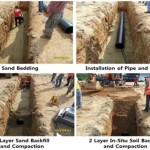Types of Bedding Geology
Bedding geology refers to the arrangement and layering of sedimentary rocks, providing insights into the geological processes and environmental conditions that shaped them. Understanding the different types of bedding can help geologists reconstruct ancient landscapes and decipher the Earth's history.
Horizontal Bedding
Horizontal bedding is characterized by layers of rock that are parallel to each other. It indicates that the sediments were deposited in a relatively calm and stable environment, such as a deep ocean basin or a floodplain. The even distribution of sediment suggests minimal disturbance or erosion during deposition.
Cross-Bedding
Cross-bedding occurs when layers of sediment are deposited at an angle to each other, forming inclined planes or ripples. This type of bedding is commonly found in river and dune environments. The angle of the cross-beds can provide information about the direction of the current or wind that transported the sediments.
Graded Bedding
Graded bedding consists of layers of sediment that vary in size and composition from bottom to top. The coarser, heavier particles settle at the base, while the finer, lighter particles are deposited on top. This type of bedding indicates changes in the energy of the depositional environment, such as a decrease in current velocity or a pause in sedimentation.
Ripple Marks
Ripple marks are small, wave-like features formed on the surface of sedimentary rocks. They are created by the interaction of water currents or wind with the sediment, producing a series of parallel ridges and troughs. The shape, size, and orientation of ripple marks can provide insights into the direction and strength of the currents or wind.
Slump Structures
Slump structures occur when a layer of sediment collapses and slides downslope, forming irregular folds and distortions. These structures are indicative of unstable conditions during deposition, such as steep slopes or earthquakes. The presence of slump structures can help geologists identify areas of ancient landslides or tectonic activity.
Load Structures
Load structures form when a layer of sediment is rapidly deposited on top of a softer, less cohesive layer. The weight of the overlying sediment deforms the underlying layer, creating folds, faults, and other irregularities. Load structures indicate rapid sedimentation and can help determine the sequence of deposition.
Channel Deposits
Channel deposits represent the ancient courses of rivers or streams. They are characterized by layers of sediment that are coarser and better sorted than the surrounding rocks. The shape and size of the channel deposits can provide information about the size and flow rate of the river or stream.
Understanding Bedding Geology
By studying the different types of bedding, geologists can gain valuable information about the geological processes and environments that shaped the Earth's surface. Bedding geology provides insights into ancient depositional systems, tectonic activity, and climatic conditions. This knowledge is essential for understanding the Earth's history and predicting future geological events.

Sepm Strata

Bedding And Lamination Geology Is The Way

Standard Flow Cell Models For Nine Typical Bedding Types Lamina Shapes Scientific Diagram
9 Standard Flow Cell Models For Nine Typical Bedding Types Lamina Scientific Diagram

Sedimentary Structure An Overview Sciencedirect Topics

Sedimentary Rocks

Learning Geology Flows Sediments And Bedforms

Bedding Plane An Overview Sciencedirect Topics

Symposium On Creation

Graded Bedding Type Of Sedimentary Deposits In Which Individual Beds Become Finer From Bottom To Top Rocks Geology








